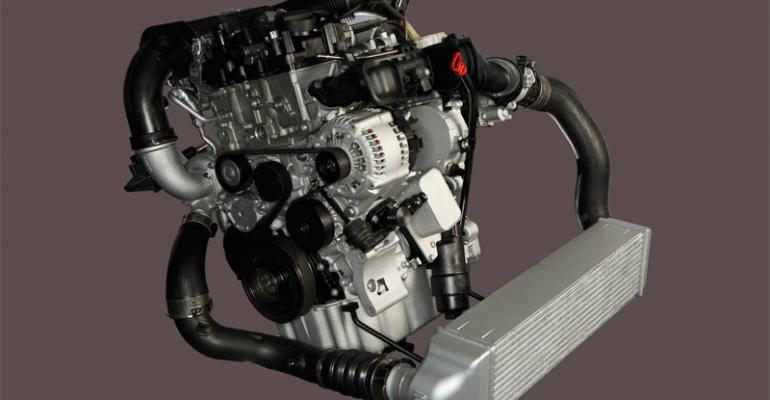WOODCLIFF LAKE, NJ – BMW unveils at the New York International Auto Show today a 1.5L 3-cyl. engine it will bring into production in coming years for global markets, as well as a new diesel-powered 3-Series sedan and enhancements to its ConnectedDrive infotainment system.
The 3-cyl. engine will bow first in the i8 plug-in hybrid-electric vehicle coming in 2014 and additional applications will follow, although the auto maker stops short of providing model information.
Heidelinde Holzer, head of integration for powertrain development, says the 3-cyl. engine answers tightening fuel-economy and emissions regulations taking hold in markets around the world, employing BMW’s suite of EfficientDynamics technologies such as high-pressure gasoline direct injection, Valvetronic continuously variable valve timing and turbocharging.
“In our opinion, we are well-positioned for future emissions requirements,” Holzer tells journalists during a presentation here Monday ahead of today’s reveal.
The engine will make 177 hp and 199 lb.-ft. (217 Nm) of torque to put its 118 hp/L on par with specific output from the auto maker’s 2.0L turbocharged 4-cyl. GDI engine, which in the U.S. now motivates vehicles such as the 3-Series and 5-Series sedans and Z4 roadster. Its red line is 6,500 rpm.
BMW does not release fuel-economy or emissions estimates, but says the new engine will improve upon the auto maker’s 2.0L GDI 4-cyl. by 5%-15% in both areas. Mated with a 6-speed automatic transmission in the 3-Series, the 2.0L 4-cyl. delivers 24-34 mpg (10-6.9 L/100 km) city/highway.
Prototypes of the 1.5L 3-cyl. engine tested briefly on BMW North America’s headquarters campus were mated with the auto maker’s latest 8-speed automatic transmission onboard a European-spec 120i hatchback.
The engine demonstrates little noise and vibration for its size and a good dose of torque in accelerating from a standstill. The exhaust note carries an oddly deep rumble for such a small engine, and BMW engineers say further development is planned in that area to impart sportiness. No active sound technology is used with the engine.
The mill owes its refinement to the addition of a balance shaft that offsets any vibration. Another year of development will further smooth out the performance. Outside of a sound-damping engine cover, BMW employs no other noise-attenuation technologies.
The all-aluminum mill weighs 17-22 lbs. (8-10 kg) less than the GDI 4-cyl. and is 1 ft. (0.3 m) shorter.
Branded with BMW’s “TwinPower” moniker, the engine uses a single-scroll turbo. It acts as quickly as the twin-turbos BMW employs on larger engines, because there is enough time between the firing of the 3-cyl. engine’s piston to open its intake valves entirely.
Stop/start also is employed, and the auto maker says it is responding to customer feedback in the U.S. over the harshness of the system, saying it continues to refine all aspects of EfficientDynamics.
The engine has a diesel-powered brother. No plans exist to bring the oil-burner to the U.S. But 40% of the parts between the diesel and gasoline 3-cyl. engine are shared and 60% of the parts between the 3-cyl. and 4-cyl. are common, giving BMW the flexibility to manufacture any of them on the same line at a number of global assembly locations. Applications include longitudinal and transverse configurations.
“We can respond swiftly to changes in the market,” Holzer says.
BMW also presents its new 2.0L 4-cyl. turbodiesel at the show. It will appear in the 328d later this year in the U.S., making 180 hp and 280 lb.-ft. (380 Nm) of torque. Expect the car to exceed 40 mpg (5.9 L/100 km) on the highway and complete a 0-60 mph (97 km/h) sprint in less than 7 seconds.
In recent years, when BMW offered the 6-cyl. diesel in the 3-Series, the take rate was about 10% for the oil burner. BMW says that diesel was meant to re-introduce the technology to U.S. consumers, and adoption was low due to the lack of an all-wheel-drive option and its high price.
Now, the new diesel comes in a less-expensive package, likely below $40,000, and mated to an 8-speed automatic transmission in a new 3-Series platform that is lighter. A sport wagon also will be available.
BMW expects the 328d to attract more customers than its predecessor, but still considers diesel car technology in its infancy in the U.S.
The auto maker also announces in New York four new iPhone app integrations for its cars, including Audible audio books, Glympse location sharing, Rhapsody subscription music service and TuneIn Internet radio.
BMW ConnectedDrive now will include a 10-year subscription to its emergency telematics service, and the technology will be included in the sticker price after previously being sold as a separate $650 4-year subscription.
The service includes enhanced automatic collision notification, where in addition to alerting emergency responders to an airbag deployment it can provide information on the severity of a crash.
ConnectedDrive also will add 4G LTE wireless connectivity to most ’14 models, creating a WiFi “hotspot” within the vehicle.





